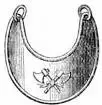Stone celts like this, and in fact ground stone artifacts in general, first appear during the Early Archaic period and unlike some axes don't have many characteristics that are useful for dating. While your theory is entirely possible, it is also possible that the piece is five or six thousand years older than what you believe. When I show some of my artifacts to people one frequent question I get is " do you know what tribe that/those are from?" and the answer is always no. I can tell you all about the historic period of this area including what Native groups were living where, who was friends with who, etc etc BUT all that type of information is from the historic period (since written records) and since the Native Americans really didn't keep any written records the "historic" period for North America only goes back as far as contact with western civilization, and in the general scheme of things that's relatively recent. So while we can make a list of Native American tribes that were in any given area in say.... 1700... it doesn't help a lot in identification of artifacts. These tribes constantly moved, merged with one another, dissappeared all together, migrated, etc. etc. of course this doesn't hold true for archaeological sites that have been excavated and found to have say a fire hearth with associated arrowheads and the carbon date comes out to be 1750 in which case we can say with at least some certainty that the associated pieces came from a particular tribe.




